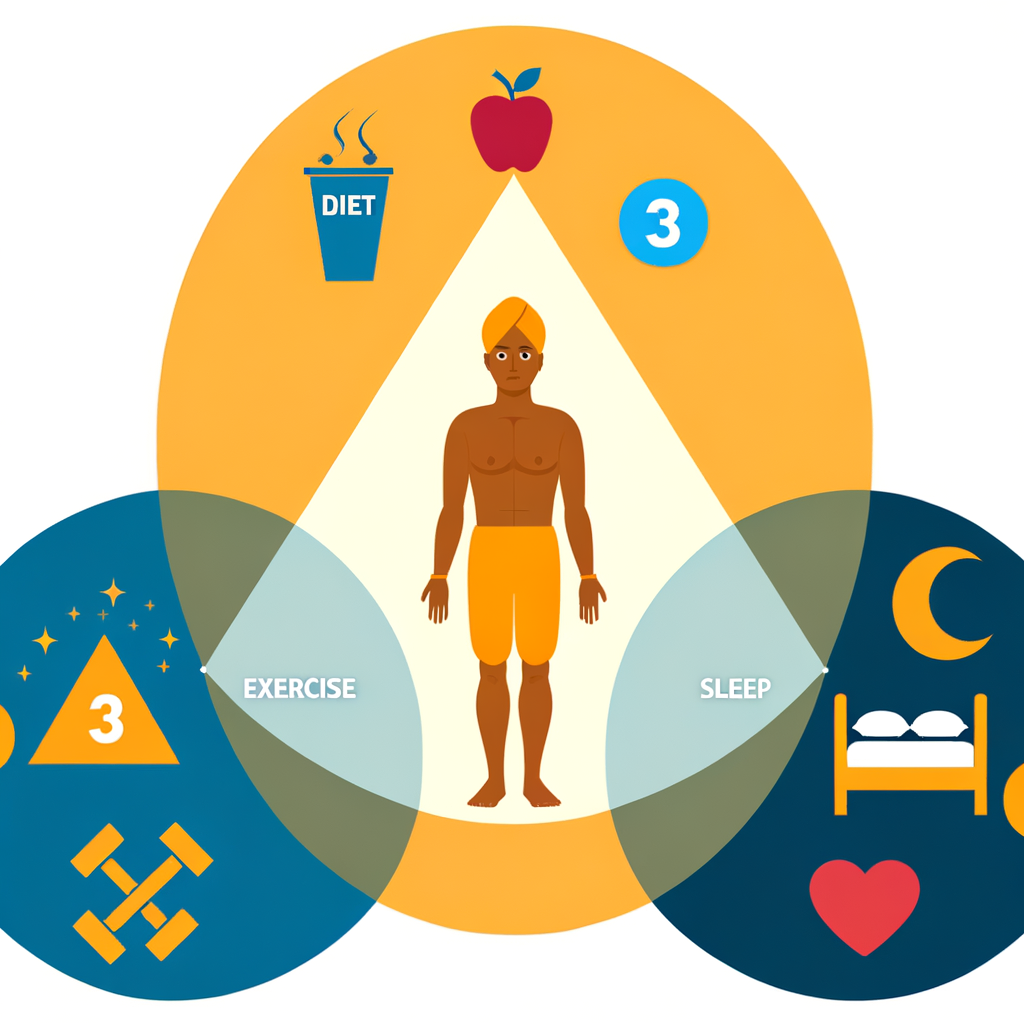The Trifecta of Healthy Aging: How Diet, Exercise, and Sleep Stabilize Blood Sugar and Turn Back the Clock
Living with diabetes—or simply aiming to maintain healthy blood sugar levels—doesn't have to feel like a constant uphill battle. The powerful combination of thoughtful eating, regular movement, and quality sleep creates a foundation for not only better glucose control but also enhanced longevity. Let's explore how these three pillars work together to help you manage your blood sugar and potentially slow the aging process.
The Blood Sugar-Aging Connection
Before diving into specific strategies, it's important to understand why blood sugar matters for aging. When glucose remains elevated in your bloodstream, it can bind to proteins throughout your body in a process called glycation. This creates harmful compounds known as advanced glycation end products (AGEs) that contribute to:
- Wrinkled, less elastic skin
- Stiffened blood vessels
- Compromised organ function
- Accelerated cellular aging
- Increased inflammation
Essentially, unstable blood sugar can make you age faster from the inside out. The good news? You have significant control over this process through three daily practices.

Dietary Approaches for Stable Blood Sugar
Your food choices form the foundation of blood sugar management. Here's how to optimize your diet:
Focus on the Glycemic Index and Load
Not all carbohydrates are created equal. Those with a lower glycemic index (GI) cause a slower, more gradual rise in blood sugar:
- Choose low-GI foods: Beans, lentils, non-starchy vegetables, and most fruits
- Limit high-GI foods: White bread, processed cereals, and sugary drinks
- Remember glycemic load: A small portion of a high-GI food may affect blood sugar less than a large portion of a medium-GI food
Embrace the Power of Fiber
Dietary fiber slows carbohydrate absorption and helps prevent blood sugar spikes:
- Aim for 25-30 grams daily
- Include both soluble fiber (oats, beans) and insoluble fiber (whole grains, vegetable skins)
- Gradually increase fiber to avoid digestive discomfort

Time Your Meals Strategically
When you eat can be almost as important as what you eat:
- Consider eating larger meals earlier in the day
- Space meals evenly throughout your waking hours
- Experiment with time-restricted eating (a form of intermittent fasting) after consulting your healthcare provider
Exercise: A Natural Blood Sugar Regulator
Physical activity creates a powerful dual effect on blood sugar management:
The Immediate Impact
A single bout of exercise increases insulin sensitivity and glucose uptake by your muscles:
- Even a 10-minute walk after meals can reduce post-meal blood sugar spikes
- Resistance training can lower blood glucose levels for up to 24 hours
- High-intensity interval training (HIIT) may provide blood sugar benefits with shorter time commitments
The Cumulative Benefit
Regular exercise creates lasting improvements in metabolism:
- Increased muscle mass means more tissue actively removing glucose from your bloodstream
- Enhanced mitochondrial function improves cellular energy utilization
- Reduced inflammation helps combat insulin resistance
Finding Your Ideal Activity
The best exercise regimen combines:
- Aerobic exercise (walking, swimming, cycling) - aim for 150 minutes weekly
- Resistance training - at least twice weekly
- Everyday movement - breaking up sedentary time with short activity breaks

Sleep: The Underappreciated Blood Sugar Hero
Poor sleep is strongly linked to blood sugar dysregulation and accelerated aging:
How Sleep Influences Glucose Metabolism
Even one night of insufficient sleep can:
- Decrease insulin sensitivity by 20-25%
- Increase stress hormones that raise blood sugar
- Trigger inflammation that contributes to insulin resistance
- Disrupt hunger hormones, often leading to poor food choices
Creating Your Sleep Sanctuary
To optimize your sleep quality:
- Maintain consistent sleep-wake times, even on weekends
- Aim for 7-9 hours of quality sleep nightly
- Create a cool, dark, quiet sleeping environment
- Limit screen time and bright lights in the hour before bed
- Consider speaking with your healthcare provider if you suspect sleep apnea, which is common in people with diabetes

Putting It All Together: Your 3-Part Strategy
These three elements—diet, exercise, and sleep—don't exist in isolation. They form an interconnected system where:
- Better sleep improves your food choices and exercise motivation
- Regular exercise enhances sleep quality and insulin sensitivity
- Proper nutrition provides energy for activity and nutrients for restful sleep
Start by making small, sustainable changes in all three areas rather than attempting a complete lifestyle overhaul. Track your blood sugar responses to different approaches to discover what works best for your unique body.

The Longevity Bonus
Beyond blood sugar control, this three-part approach offers additional anti-aging benefits:
- Reduced oxidative stress and cellular damage
- Improved cardiovascular function
- Enhanced cognitive performance
- Stronger immune function
- Better mood and stress resilience
By prioritizing diet, exercise, and sleep as your foundation for blood sugar management, you're not just controlling diabetes—you're potentially adding healthy, vibrant years to your life.
Remember that individual responses vary, and it's essential to work with your healthcare team to create a personalized approach that accounts for your specific health needs, medications, and circumstances.
References:
Colberg, S. R., Sigal, R. J., Yardley, J. E., Riddell, M. C., Dunstan, D. W., Dempsey, P. C., Horton, E. S., Castorino, K., & Tate, D. F. (2016). Physical Activity/Exercise and Diabetes: A Position Statement of the American Diabetes Association. Diabetes Care, 39(11), 2065–2079.
Spiegel, K., Tasali, E., Leproult, R., & Van Cauter, E. (2009). Effects of poor and short sleep on glucose metabolism and obesity risk. Nature Reviews Endocrinology, 5(5), 253-261.






